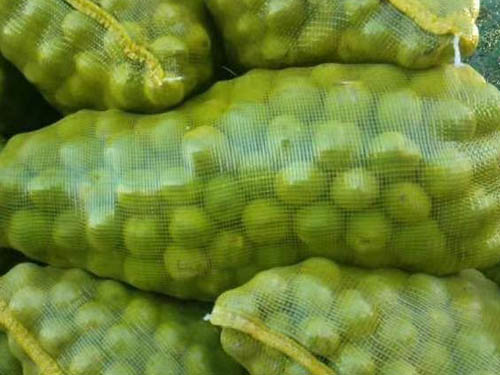As a professional mesh bags manufacturer, we have researched on mesh bags technology and shared that in daily life, mesh bags are widely used to contain onions, garlic, potatoes, carrots and other agricultural products. When mesh bags are in outdoor environment, their quality will be affected by many factors. Understanding these factors is important to ensure the normal use of mesh bags and extend their service life.
Raw material is one of the key factors affecting the quality of mesh bags. Polyethylene (PE), polypropylene (PP) and other plastic raw materials are usually used to make mesh bags. If the purity of the raw materials is not high and contains more impurities, then the strength of the mesh bags made will be greatly reduced. For example, the presence of impurities may cause the mesh bag to have stress concentration points during stretching, resulting in the bag rupturing easily. In addition, the performance of different grades of raw materials varies significantly. Mesh bags made of high-quality raw materials, its flexibility, abrasion resistance and weather resistance are better, able to withstand greater tensile strength and erosion of the external environment. On the contrary, low-grade raw materials produced by the mesh bag may be fragile texture, a little outdoors in the sun and wind will appear aging, brittle phenomenon.

The production process also largely determines the quality of mesh bags. The production process of drawing process is very critical, if the drawing is not uniform, mesh bag wire diameter thickness varies, then in the force, the finer parts will be easy to break. Weaving process is equally important, the density of weaving, stitching, etc. will affect the strength and stability of mesh bags. Tight, even weave can make the mesh bag can withstand more weight, and in the outdoor environment is more difficult to deformation. For example, a sparsely woven mesh bag is not only easy to let the contents of the bag fall, but also in the wind, the mesh is too large to make the wind on the bag to increase the force, accelerating the damage to the bag.
Outdoor lighting conditions have a significant impact on the quality of mesh bags. The ultraviolet rays in sunlight are very energetic and can destroy the chemical bonds of plastic molecules. Prolonged outdoor exposure to the sun will make the plastic molecules in the mesh bag degradation, resulting in the gradual lightening of the color of the bag, the texture becomes brittle. The original mesh bag with good flexibility, after a period of UV exposure, may be gently folded will break. This light aging phenomenon greatly shortens the service life of mesh bags.

Temperature changes are also important factors affecting the quality of mesh bags. In the hot summer, the outdoor temperature is high, the plastic will be in a relatively soft state, the strength of the mesh bag will be reduced. If the loaded items are heavy, the mesh bag is easy to deform or even broken. And in the cold winter, the plastic will become brittle, low temperature makes the mesh bag flexibility loss, in the handling or by a slight external impact, there may be a rupture.
Humidity environment should not be ignored. Outdoor humidity is usually greater, especially in rainy days or humid areas. Mesh bags are prone to absorb water when they are in a humid environment for a long time. For some plastic materials that are not water-resistant, the intrusion of water may trigger hydrolysis reactions, destroying the plastic molecular structure and reducing the performance of mesh bags. And humid environment is also easy to breed mold and other microorganisms, microbial erosion will also cause damage to the mesh bags.
To summarize, raw materials, production process and outdoor light, temperature, humidity and other factors, all from different aspects of the mesh bags quality. Only by fully considering and responding to these factors can we ensure that mesh bags work better in outdoor environments and provide reliable protection for the storage and transportation of agricultural products.



